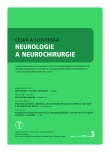Nuclear Medicine Examination of Cerebrovascular Reserve Capacity and Other Complementary Methods
Authors:
P. Širůček; O. Kraft
Authors‘ workplace:
Klinika nukleární medicíny FN Ostrava
Published in:
Cesk Slov Neurol N 2010; 73/106(3): 227-230
Category:
Review Article
Overview
The assessment of the cerebrovascular reserve capacity (CVRC) of the brain in patients with occlusion of the internal carotid artery is one of the procedures that is included in the planning of revascularization bypass surgery. The authors present an examination method of which they have experience – stress brain single photon emission computed tomography (SPECT) with carbon dioxide. Basic information regarding two nuclear medicine methods, brain SPECT using the 133Xe and positron emission tomography using the 15O, are also presented. The latter method is considered the gold standard in CVRC examination. Other nonradionuclide imaging methods, transcranial Doppler sonography, perfusion computed tomography of the brain, and functional magnetic resonance imaging, are also mentioned.
Key words:
cerebrovascular reserve capacity – brain SPECT – hypercapnia – acetazolamide
Sources
1. Herzig R, Školoudík D. Vyšetření cerebrální vazomotorické reaktivity u pacientů s chronickou okluzí vnitřní krkavice pomocí ultrazvuku. Neurol pre prax 2007; 4 : 206 – 207.
2. Beneš V et al. Ischémie mozku: chirurgická a endovaskulární terapie. 1st ed. Praha: Galén 2003.
3. Nevšímalová S, Růžička E, Tichý J et al. Neurologie. 1st ed. Praha: Galén 2000.
4. Mohapl M, Svobodová J, Beneš V. Vyšetřování cerebrovaskulární rezervní kapacity. Cesk Slov Neurol N 2004; 67/ 100(1): 12 – 15.
5. Kuroda S, Kamivama H, Abe H, Houkin K, Isobe M, Mitsumori K. Acetazolamide test in detecting reduced cerebral perfusion reserve and predicting long‑term prognosis in patients with internal carotid artery occlusion. Neurosurgery 1993; 32(6): 912 – 919.
6. Müller M, Schimrigk K. Vasomotor reactivity and pattern of collateral blod flow in severe occlusive carotid artery disease. Stroke 1996; 27(2): 296 – 299.
7. Ringelstein EB, Van Eyck S, Mertens I. Evaluation of cerebral vasomotor reactivity by various vasodilating stimuli: comparison of CO2 to acetazolamide. J Cereb Blood Flow Metab 1992; 12(1): 162 – 168.
8. Hugh M, Marisa C. Severely impaired cerebrovascular reactivity predicts stroke and TIA risk in patients with carotid artery stenosis and occlusion. Brain 2001; 124(3): 457 – 476.
9. Stoll M, Hamann GF. Cerebrovascular reserve capacity. Nervenarzt 2002; 73(8): 711 – 718.
10. Engelhardt M, Pfadenhauer K, Zentner J, Grimmer S,Wachenfeld ‑ Wahl C, Heidenreich P et al. Störung der zerebralen Perfusionsreserve bei asymptomatischen Patienten mit A. carotis interna ‑ Stenose: Vergleich von Acetazolamid ‑ SPECT und transkranieller CO2-Dopplersonographie. Zentralbl Chir 2004; 129(3): 178 – 182.
11. Kleiser B, Widder B. Course of carotid artery occlusions with impaired cerebrovascular reactivity. Stroke 1992; 23(2): 171 – 174.
12. Müller M, Voges M, Piepgras U, Schimrigk K. Assessment of cerebral vasomotor reactivity by transcranial Doppler ultrasound and breath ‑ holding. A comparison with acetazolamide as vasodilatory stimulus. Stroke 1995; 26(1): 96 – 100.
13. Shiogai T, Koshimura M, Murata Y, Nomura H, Doi A, Makino M et al. Acetazolamide vasoreactivity evaluated by transcranial harmonic perfusion imaging relationship with transcranial Doppler sonography and dynamic CT. Acta Neurochir Suppl 2003; 86 : 57 – 62.
14. Hauge A, Nicolaysen G, Thoresen M. Acute effects of acetazolamide on cerebral blood flow in man. Acta Physiol Scand 1983; 117(2): 233 – 239.
15. Elgazzar AH. The pathophysiologic basis of nuclear medicine. Berlin: Springer 2001.
16. Sameš M., Zolal A, Radovnický T, Vachata P, Bartoš R, Derner M. Použití metod magnetické rezonance pro posouzení cerebrovaskulární rezervní kapacity. Cesk Slov Neurol N 2009; 72/ 105(4): 323 – 330.
17. Bisdas S, Nemitz O, Berding G, Weissenborn K,Ahl B, Becker H et al. Correlative assessment of cerebral blood flow obtained with perfusion CT and positron emission tomography in symptomatic stenotic carotid disease. Eur Radiol 2006; 16(10): 2220 – 2228.
18. Sameš M, Bartoš R, Vachata P, Zolal A, Cihlář F, Derner M et al. Hodnocení cerebrovaskulární rezervní kapacity po EC ‑ IC bypassu pomocí TCD. Cesk Slov Neurol N 2009, 72/ 105(4): 359 – 363.
19. Hoeffner EG, Case I, Jain R, Gujar SK, Shah GV, Deveikis JP et al. Cerebral perfusion CT: technique and clinical applications. Radiology 2004; 231(3): 632 – 644.
20. Oku N, Matsumoto M, Hashikawa K., Moriwaki H,Okazaki Y, Seike Y et al. Carbon dioxide reactivity by consecutive technetium 99m HMPAO SPECT in patients with a chronically obstructed major cerebral artery. J Nucl Med 1994; 35(1): 32 – 40.
Labels
Paediatric neurology Neurosurgery NeurologyArticle was published in
Czech and Slovak Neurology and Neurosurgery

2010 Issue 3
- Memantine Eases Daily Life for Patients and Caregivers
- Hope Awakens with Early Diagnosis of Parkinson's Disease Based on Skin Odor
- Metamizole vs. Tramadol in Postoperative Analgesia
- Metamizole at a Glance and in Practice – Effective Non-Opioid Analgesic for All Ages
- Metamizole in the Treatment of Acute Postoperative Pain
Most read in this issue
- Spondylotic Cervical Myelopathy
- Fractures of the Fifth Lumbar Vertebra
- Standardization of the Czech Version of The Confusion Assessment Method for the Intensive Care Unit (CAM‑ICUcz)
- Complicated Herpetic Necrotising Meningoencephalitis Requiring Neurosurgical Intervention – a Case Report
